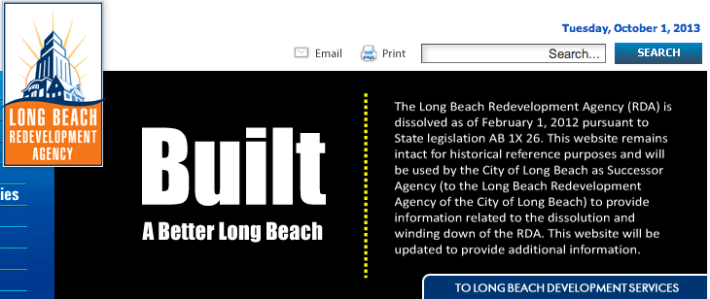
In December of 2011, the state formally dissolved all Redevelopment Agencies (RDAs) in an effort to balance the budget while cutting state costs. This was ultimately a blow to many devastated communities whose RDAs were vastly responsible for a given city's structural and social health, including increasing the walkability of streets, the beautification of sidewalks, the modernization of building facades, and other key components eradicating blight in a given city space.
It was, unquestionably, a setback for many cities, including Long Beach. After all, every city with a RDA had to deal with not just an immediate loss of some $5.5B but also reverse some 60 years of public policy.
RDA supporters, led by Long Beach's neighbor to the north, the City of Bellflower, attempted to challenge the legality of the state's dissolution. However, they ultimately ended up in a worse situation when the California Supreme Court upheld the most stringent parts of the dissolution while declaring aspects that might help the agencies unconstitutional. It was clear at the RDA was a non-existent entity come February of 2012.
As we approach the two-year mark of that dissolution, Long Beach—like every city with a RDA as required per post-RDA law—is hoping to approve what the call a Long Range Property Management Plan that will formally address what to precisely do with the 259-plus properties that were under the management of the RDA.
The plan, generically speaking, has two aims: to figure out precisely what to do with all these properties and how to do so without harming the city financially or opportunistically.
The properties will be broken into four categories:
- Government Use: "properties or assets that were or will be constructed for use as roads, parks and park facilities, police or fire stations, libraries and other administration buildings" which will continue to belong to the government;
- Enforceable Obligation: pretty much means they had previous obligations for their use which must be met (think a contract signed before RDAs were dissolved);
- Future Development: "properties acquired for a purpose or project identified in the related redevelopment plan," i.e. plans that don't fall into #2 or #4—speaking of which;
- Properties for Sale: "properties not assembled into developable sites and will be disposed through traditional marketing practices," i.e. sold.
Most interesting is #3—Future Development—which is really just another category for the fact that the city wants to take as many sites and (seemingly) on its own take on the role of RDA. A massive majority of the properties, 161, plan to be put into this category through its proposal.
A main concern with this might be the fact that many felt the RDA of Long Beach was Downtown-centric in its development; however, it appears that 33 of the 161 designated "future development" properties lie in Downtown, with the others spread throughout the city.
The other central question that remains, particularly from those in the less-RDA-centric hoods of Central, North, and West Long Beach, is how funds from these properties will be dispersed: will funds, if raised, be directed back into those direct neighborhoods or will, given their ownership by the city a la "future development" categorization, be distributed where the city sees fit?
The plan is set to face the Successor Agency (the City Council) today, followed by the Oversight Board to the Successor Agency on October 7. Its final destination will be the Department of Finance on October 23.
1. In 1952, California was the first state to implement tax increment financing to create the RDA process. In short: "RDAs issued tax allocation bonds to finance redevelopment projects. The bonds are secured by the promise of tax increment revenue - the expected tax increases generated by redevelopment - and are senior to all other potential uses of the money."






